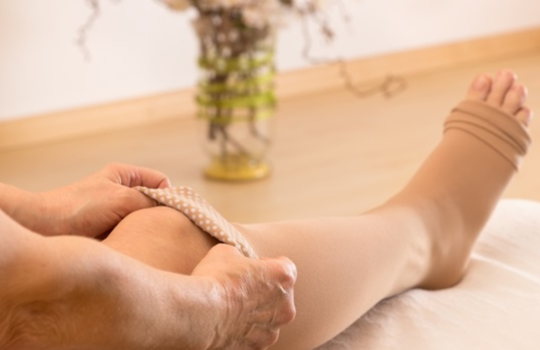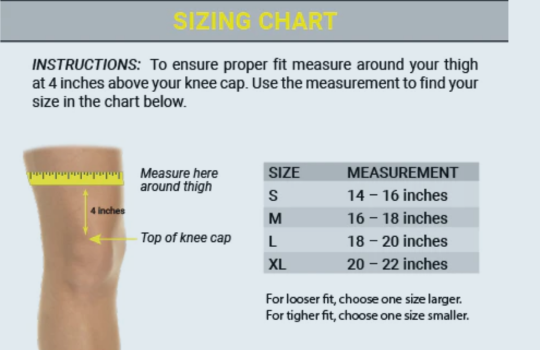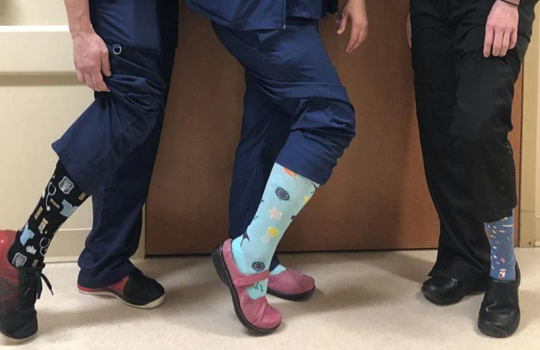Diabetic Socks vs Compression Socks: Choosing the Right Support for Your Feet
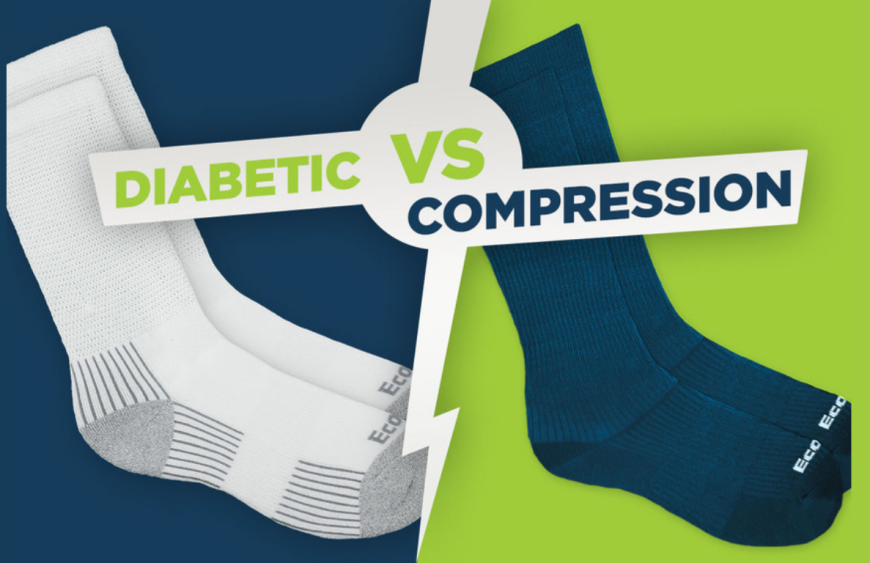
Table of Contents
Introduction
The right choice of socks can make a significant difference in maintaining foot health. This article explores two specialized types of socks, diabetic socks vs compression socks, designed to address specific needs. Understanding their benefits and differences will help you decide the best option for your feet.
What are Diabetic Socks and Compression Socks?
Before delving into the specifics, let’s establish a clear understanding of what diabetic socks and compression socks are. Diabetic socks are tailored to the needs of individuals with diabetes, focusing on comfort and protection. On the other hand, compression socks are designed to improve circulation by applying pressure to the legs.
Who Needs Diabetic Socks or Compression Socks?
Diabetic Socks
Diabetic socks can be invaluable companions for individuals with diabetes, particularly those suffering from poor circulation, neuropathy or who have experienced complications related to foot health. These specially made socks provide a snug yet protective fit, helping prevent blisters, ulcers, and infections by wicking away moisture, reducing friction, and minimizing pressure points thus decreasing skin damage risks and increasing comfort levels. People with diabetes also benefit significantly from wearing diabetic socks as it assists in maintaining stable blood circulation, which helps foot health and lowers risks associated with severe complications related to complications arising as a result.
Compression Socks
Compression socks offer numerous health and lifestyle advantages to individuals of all kinds. People with circulatory conditions such as varicose veins, deep vein thrombosis (DVT), or edema typically require compression socks to facilitate blood flow and reduce swelling. Travelers, particularly on long flights, can benefit from wearing compression socks to minimize the blood clot risk associated with prolonged sitting. Athletes might use compression socks post exercise to speed recovery time and reduce soreness. Healthcare workers or office employees who spend extended periods sitting or standing can relieve leg discomfort and fatigue with compression socks that promote better circulation and overall leg health.
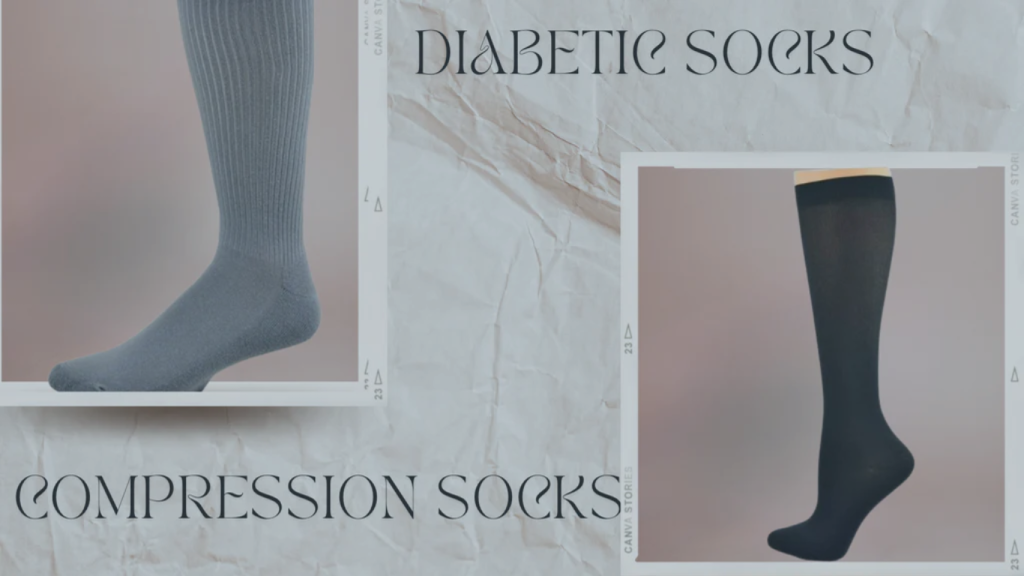
If you found this information on diabetic care helpful, you’ll definitely want to check out our comprehensive guide on diabetic compression socks. Dive deeper into how these specialized socks can enhance your comfort and well being. Don’t miss out on expert insights and tips that can make a real difference.
Benefits of Diabetic Socks vs Compression Socks
| Benefit | Diabetic Socks | Compression Socks |
| Comfort | Prioritize comfort for individuals with diabetes, often featuring soft, breathable materials. | Offer a snug fit that can provide a feeling of support and relief to the legs. |
| Moisture Management | Designed to wick away moisture, keeping feet dry and reducing the risk of fungal infections. | Help manage moisture and perspiration, maintaining skin health and reducing discomfort. |
| Protection | Special features like seamless toes and heels minimize friction and prevent blisters or sores. | Provide support and protection to the legs, reducing the risk of injury and enhancing overall leg health. |
| Circulation Support | Aim to improve blood circulation in the feet. | Graduated compression enhances blood flow from the legs to the heart, reducing swelling and preventing blood pooling. |
| Swelling Reduction | Help reduce mild swelling in the feet. | Effectively minimize swelling in the legs and feet, making them beneficial for various conditions. |
| Risk of Blood Clots | Aid in reducing the risk of blood clots and related complications. | Significant in preventing deep vein thrombosis (DVT) and promoting healthy blood flow. |
| Venous Health | Assist in maintaining healthy veins and preventing venous disorders. | Support venous health by encouraging proper blood flow, which is particularly crucial for individuals with circulation issues. |
| Arch Support | May provide moderate arch support for added comfort. | Often include arch support to alleviate strain and enhance overall foot comfort. |
| Injury Prevention | Suitable for individuals at risk of foot injuries due to neuropathy. | Help prevent injuries by offering stability and support to the legs and feet. |
| Varied Options | Available in a range of styles and materials to suit different preferences. | Offer various compression levels and styles, catering to specific medical needs and personal preferences. |
Differences between Diabetic Socks vs Compression Socks
| Aspect | Diabetic Socks | Compression Socks |
| Purpose | Designed for individuals with diabetes, focusing on comfort and protection. | Aim to improve blood circulation and reduce swelling in the legs. |
| Fit | Typically looser fitting for added comfort. | Snug fit to provide graduated pressure. |
| Pressure | Do not apply graduated pressure. | Apply graduated pressure to the legs. |
| Materials | Often made from breathable materials that wick away moisture. | Can be crafted from various materials. |
| Features | May include seamless toes and heels to prevent rubbing and blisters. | Often feature graduated compression, arch support, or other specialized elements. |
| Ideal for | Sensitive skin High risk of foot injuries Poor circulation | Leg or feet swellingVenous disorders Deep vein thrombosis (DVT) |
| Benefits | Focus on comfort and moisture control. | Aid in improved blood circulation, reducing swelling, and preventing blood clots. |
| Cost | Varies based on brand and features. | Prices can vary depending on brand and level of compression. |
| Availability | Found in many drugstores and online shops. | Widely available in medical supply stores and online. |
| Purchase Consideration | Consider individual foot conditions and comfort. | Consider the level of compression needed and specific medical conditions. |
| Consultation | Consult your doctor or podiatrist for personalized advice. | Always consult a medical professional to determine appropriate compression levels. |
Choosing the Right Sock
When deciding between diabetic socks and compression socks, consider your specific needs:
Diabetic Socks: Tailored Comfort and Protection
If you have diabetes, your feet require special care. Diabetic socks are designed for those with sensitive skin, a high risk of foot injuries, and poor circulation common challenges linked to diabetes.
Sensitive Skin: These socks use gentle, breathable materials to prevent irritation and blisters.
High Risk of Injuries: Diabetic socks offer extra cushioning to guard against potential injuries, which is crucial if you have reduced sensation due to neuropathy.
Poor Circulation: Designed to enhance blood flow, diabetic socks help maintain foot health despite circulation issues.
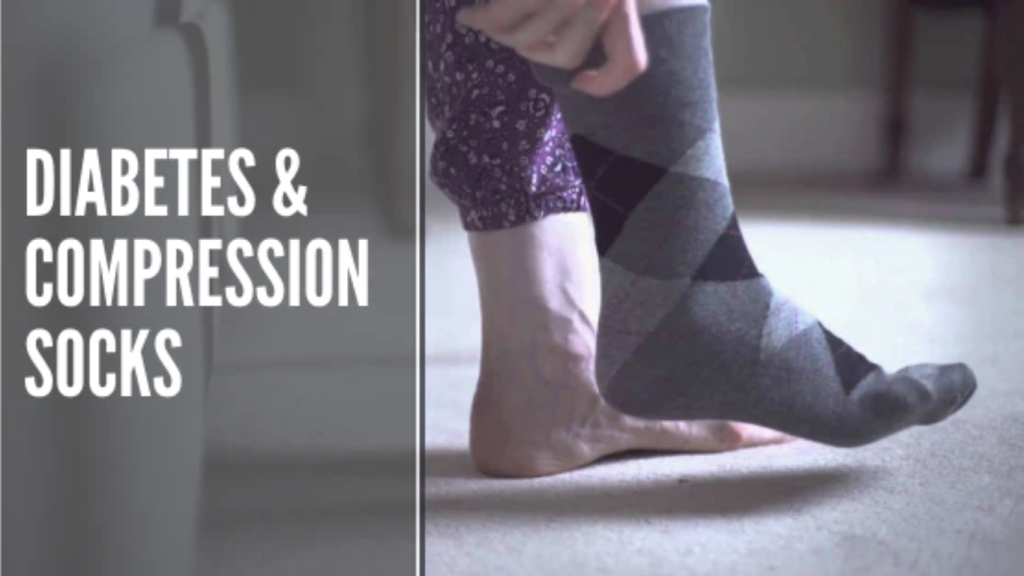
Compression Socks: Supporting Leg Wellness
Compression socks are tailored for specific leg concerns, making them an excellent choice for:
Leg Swelling: These socks reduce swelling in legs and feet, enhancing comfort and mobility.
Venous Disorders: Designed to aid blood flow, they alleviate symptoms like aching and heaviness caused by venous issues.
Deep Vein Thrombosis (DVT): Compression socks help prevent dangerous blood clots by promoting healthy blood circulation.
Conclusion
In foot health, the choice between diabetic socks vs compression socks is crucial. Diabetic socks offer comfort and protection, while compression socks tackle swelling and circulation issues. Your decision should align with your specific needs and preferences. Prioritize comfort, and safety, and seek professional advice for a confident stride toward healthier feet.
Remember: Always consult your doctor or podiatrist to determine which type of sock fits you.

